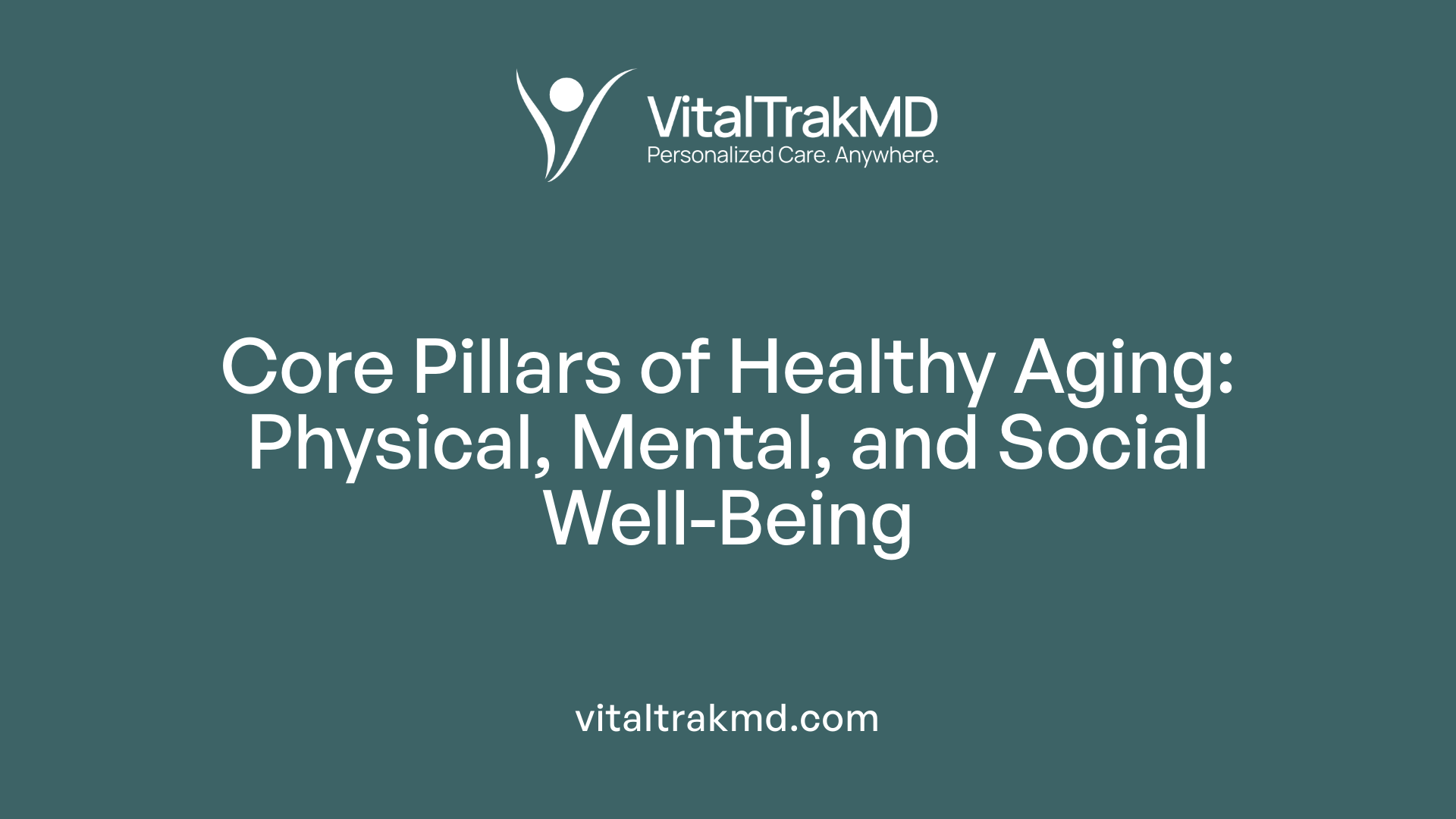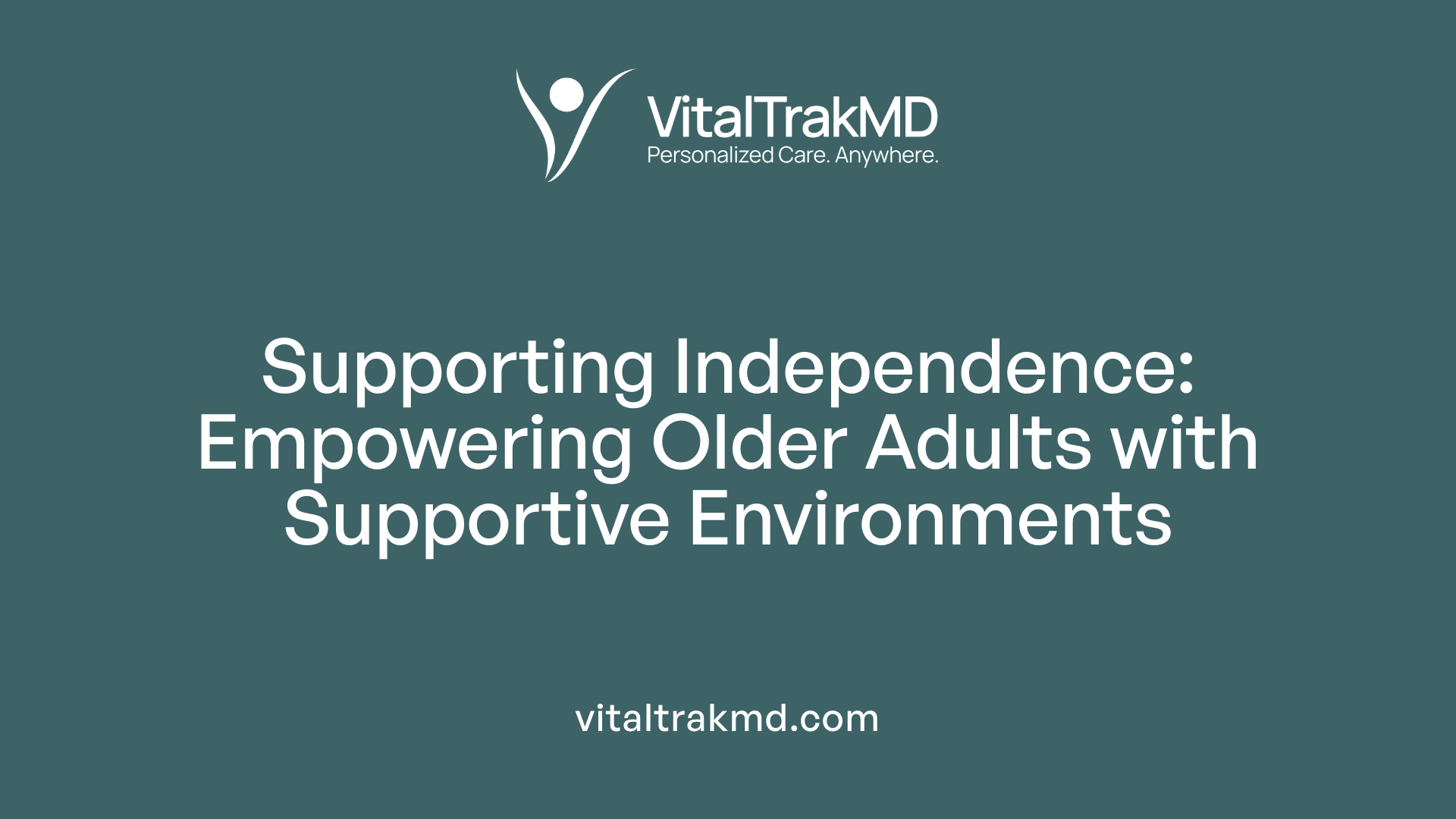Planning Long-Term Health Strategies for Aging Adults

Why Long-Term Health Strategies Are Critical for Aging Adults
As the global population ages at an unprecedented rate, the imperative to develop comprehensive, sustainable long-term health strategies becomes urgent. An effective approach not only enhances individual quality of life but also ensures systems are prepared to support the diverse needs of older adults. This article explores key components of healthy aging, the benefits of aging in place, strategic planning, and innovative frameworks that policymakers and communities can adopt to promote vibrant, independent aging.
Understanding the Pillars of Healthy Aging

What are the main components of healthy aging?
Healthy aging is a multifaceted process that involves several important lifestyle and behavioral strategies. These core elements help older adults maintain their independence, improve quality of life, and reduce the risk of chronic illness and cognitive decline.
The primary components include regular physical activity, nutritious eating, social engagement, cognitive stimulation, and mental well-being.
Connecting with others through community activities, maintaining a balanced diet rich in fruits, vegetables, lean proteins, and healthy fats, and staying active with at least 150 minutes of moderate exercise weekly are vital. Additionally, engaging in hobbies, learning new skills, and participating in social groups support cognitive health and emotional resilience.
Psychological practices such as stress management, mindfulness, and fostering a sense of purpose also significantly contribute to overall health. Combining these elements creates a comprehensive approach that empowers older adults to age healthfully and gracefully.
The Advantages of Aging in Place and Community-Centric Living
What are the benefits of aging in place?
Aging in place allows older adults to remain in their own homes and communities as they age, which offers numerous advantages. Most importantly, it helps maintain independence by enabling seniors to manage their daily routines in familiar surroundings. Staying in a familiar environment supports a sense of identity and continuity, which are crucial for emotional well-being.
Beyond personal comfort, aging in place fosters social connections. Remaining active within their communities helps older adults stay engaged, reducing feelings of loneliness and social isolation—factors linked to poorer health outcomes, including depression, heart disease, and cognitive decline. By maintaining community ties, older adults can participate in social activities, volunteer work, and other engagement opportunities that promote mental and emotional health.
A significant benefit of aging in place is cost-effectiveness. It can be more affordable than moving to assisted living or nursing facilities, especially for those on fixed incomes. Home modifications such as ramps, grab bars, and improved lighting enhance safety and accessibility, decreasing the risk of falls and injuries. Community programs and services, like transportation and home care support, further enable seniors to live comfortably and securely at home.
Overall, aging in place enhances quality of life by supporting independence, fostering emotional health, and integrating older adults into their communities. It promotes a healthier, more connected, and cost-efficient approach to aging, with well-planned efforts ensuring safety and accessibility for seniors.
Strategies for Supporting Aging Adults Effectively
Supporting older adults in maintaining independence and a high quality of life involves multiple interconnected strategies. Encouraging self-management of chronic diseases through education and regular healthcare visits helps older individuals stay healthier longer. Facilitating easy access to healthcare services, including community health centers and telehealth options, allows timely medical attention and ongoing management of health conditions, especially for those with mobility challenges.
Fostering social engagement is essential to combat loneliness and social isolation, which are linked to depression, heart disease, and cognitive decline. Community programs, social clubs, and regular contact with family and friends contribute to mental and emotional well-being.
Creating environments that are accessible and safe is equally important. Age-friendly infrastructure, such as ramps, handrails, improved lighting, and home modifications, helps older adults navigate their spaces confidently and reduces fall risks. Supportive technologies, like emergency alert systems and mobility aids, further enhance independence.
Coordination among healthcare providers, caregivers, and community organizations is crucial to deliver comprehensive, person-centered care. This collaboration ensures that health, social, and supportive needs are addressed holistically.
Lastly, promoting healthy lifestyle behaviors plays a vital role. Regular physical activity, a nutritious diet rich in fruits, vegetables, and lean proteins, and routine preventive screenings can prevent or delay the onset of chronic diseases, enhancing overall well-being. These combined efforts foster a supportive environment that empowers aging adults to live actively and independently.
Planning Effective Health Promotion Strategies for the Elderly

How can health promotion strategies be planned for older adults?
Planning health promotion strategies for older adults requires a comprehensive approach that addresses their physical, mental, and social well-being. One of the primary focuses should be on preventing social isolation and loneliness, which are common issues that negatively impact health, leading to increased risks of depression, heart disease, and cognitive decline. Facilitating community engagement and social activities can help maintain social connections and foster a sense of belonging.
Incorporating regular physical activity into daily routines is vital. Experts recommend at least 150 minutes of moderate-intensity exercise each week, including activities like walking, swimming, or cycling. Strength training exercises twice weekly can improve muscle mass, strength, and balance, reducing fall risk.
Promoting healthy eating is another cornerstone of health promotion. Adopting dietary guidelines that emphasize a variety of fruits, vegetables, whole grains, healthy fats, and lean proteins supports immune function, bone health, and reduces the likelihood of chronic illnesses such as diabetes and heart disease.
Regular health check-ups and screenings play a crucial role in early diagnosis and management of health conditions. Routine visits allow healthcare providers to monitor the effectiveness of treatments, update vaccinations, and catch potential issues before they become serious.
Supporting older adults also involves providing education and resources for caregivers. Training and information can enhance caregiving quality, reduce stress, and improve outcomes. Stress management techniques, engaging in new learning opportunities, and nurturing hobbies contribute to mental health and overall happiness.
Overall, designing effective health promotion strategies demands collaboration among healthcare providers, community organizations, families, and the older adults themselves. Tailoring programs to individual needs and promoting accessible, age-friendly environments are essential steps to foster healthier, more independent aging.
Tips for Promoting Healthy Aging

What are effective tips for healthy aging?
Adopting healthy habits is crucial as we grow older. A balanced diet rich in fruits, vegetables, whole grains, and healthy fats like omega-3s found in fish and nuts helps support overall health. Limiting red meats, saturated fats, and sugary foods can reduce chronic disease risk.
Physical activity plays a vital role in maintaining independence and mental well-being. Incorporating walking routines, strength training, and balance exercises at least 150 minutes weekly, along with muscle-strengthening activities twice a week, can lower fall risks and improve mobility.
Social engagement and mental stimulation are equally important. Staying connected with family and friends, volunteering, learning new skills, or participating in hobbies can help preserve cognitive health and emotional resilience.
Routine health checkups, including screenings and vaccinations, enable early detection of issues and prevent disease progression. Managing medications properly and staying current with immunizations such as influenza and pneumonia vaccines support long-term health.
Managing stress through techniques like meditation or yoga, ensuring sufficient sleep, practicing good personal hygiene, and steering clear of smoking and excessive alcohol intake further bolster aging well.
Maintaining these behaviors consistently can significantly enhance quality of life, ensuring older adults remain active, healthy, and emotionally fulfilled.
Overview of Long-Term Care Facilities and Support Services

What are common types of long-term care facilities?
Long-term care options are diverse, designed to meet the varying needs of aging adults and individuals with disabilities. The most recognized types include nursing homes, assisted living facilities, community-based residential settings like Continuing Care Retirement Communities (CCRCs), and small care homes.
Nursing homes, also known as skilled nursing facilities, provide comprehensive medical care and assistance with daily activities for residents with complex health problems. These facilities are equipped to deliver continuous health monitoring, rehabilitation, and custodial care.
Assisted living facilities cater to those who need help with daily tasks such as bathing, dressing, and medication management but wish to maintain independence. These settings emphasize social engagement, activities, and a supportive environment.
Continuing Care Retirement Communities (CCRCs) are multi-level living arrangements that include independent living, assisted living, and skilled nursing care within a single campus. This setup offers residents flexibility to access varying levels of care as their health needs evolve without relocating.
Small care homes, often called board and care homes, are private residences that provide personalized care, meals, and assistance with daily routines. These homes usually serve fewer residents, creating a homelike atmosphere, but they typically offer limited medical services.
Services provided — medical, personal, social, and supportive
Long-term care facilities offer a broad range of services tailored to individual needs. Medical services include routine health monitoring, medication management, rehabilitation therapies, and emergency care.
Personal care services encompass assistance with daily activities such as bathing, grooming, mobility, and eating.
Social and recreational programs are vital for mental and emotional well-being, featuring activities like games, outings, educational programs, and community events.
Support services extend to transportation, housekeeping, meals, and 24-hour supervision, fostering a supportive environment that promotes independence and quality of life.
Transition options as needs change
As health and functional status evolve, many older adults transition between different levels of care. For instance, a person may start in assisted living and later move to a nursing home if medical needs increase.
CCRCs and similar communities facilitate this process internally, allowing residents to stay within a familiar community while accessing appropriate support. Planning for these transitions early is essential for maintaining continuity of care and reducing stress.
Advantages and limitations of each type
| Facility Type | Advantages | Limitations |
|---|---|---|
| Nursing Homes | Provide comprehensive medical care, specialized services, and 24/7 supervision. | Higher costs, less privacy, and potential for institutional environment. |
| Assisted Living | Promote independence, social engagement, and personalized support. | Limited medical care compared to nursing homes, with restrictions on severe health conditions. |
| CCRCs | Offer flexible levels of care within one community, easing transitions. | Can be expensive; sometimes limited availability of full spectrum services. |
| Small Care Homes | Homelike atmosphere, personalized attention. | Limited medical services, suitable mainly for less complex needs. |
Choosing the right facility involves assessing current health status, personal preferences, financial considerations, and future needs. Awareness of the advantages and constraints ensures informed decision-making to support long-term well-being.
Supporting Independence While Receiving Support

How can older adults maintain independence while receiving support?
Maintaining independence is a vital aspect of healthy aging. Older adults can continue to enjoy a fulfilling, autonomous life by actively engaging in their hobbies, social activities, and daily routines. These activities help preserve their sense of purpose, cognitive function, and self-esteem.
Providing accessible clothing and safety modifications around the home plays a crucial role. Installing grab bars in bathrooms, ramps for doorways, and ensuring proper lighting can prevent falls and make daily activities safer and easier. These adaptations allow older adults to perform routine tasks with greater confidence.
Creating a safe and organized environment within the home further supports independence. Removing hazards like loose rugs, securing cords, and storing dangerous items out of reach minimizes the risk of accidents. Proper safety features, such as smoke alarms and non-slip mats, contribute to a secure living space.
Supporting mental and physical health is equally important. Encouraging regular exercise, mental stimulation through puzzles or learning new skills, and maintaining open communication fosters overall well-being. Access to healthcare services and social connections are essential components of healthy aging.
Respect for personal choices and involving older adults in decisions about their care and living arrangements help uphold their dignity. Listening to their preferences and empowering them to make choices about their support ensures they retain a sense of control and autonomy.
Overall, integrating these strategies creates a supportive environment where older adults can maintain their independence, experience a higher quality of life, and age with dignity.
A Roadmap Toward a Future of Healthy, Independent Aging
Developing and implementing robust, multi-faceted long-term health strategies for aging adults is vital for fostering resilience, independence, and well-being across the lifespan. By integrating preventive health measures, community engagement, supportive environments, and comprehensive care planning, societies can better meet the diverse needs of their aging populations. Successful aging not only benefits individuals but also reduces healthcare burdens, facilitates social cohesion, and promotes economic sustainability. As nations craft policies, innovate care models, and harness emerging technologies, a collaborative effort that centers on dignity, equity, and inclusion will be essential in shaping a future where aging is recognized as a stage of vibrant opportunity rather than decline.
References
- Healthy Aging Tips for the Older Adults in Your Life
- A Caregiver's Guide to Long-Term Care Planning
- Healthy Aging Resources | odphp.health.gov
- What Is Long-Term Care? | National Institute on Aging
- Guide to Planning for Aging Seniors by the NCPC
- Aging Well: Resources for a Happy and Healthy Life
- Comprehensive Policy Approaches to Support the Aging Population
- Long-Term Services and Supports for Older Adults: A Position Paper ...
- How to promote healthy aging across the life cycle - ScienceDirect
Recent articles
Want to Feel Better and Live Healthier?
Join hundreds of patients taking control of their health with personalized care that fits their life – not the other way around.
Rated 4.8/5 by 32+ customers







